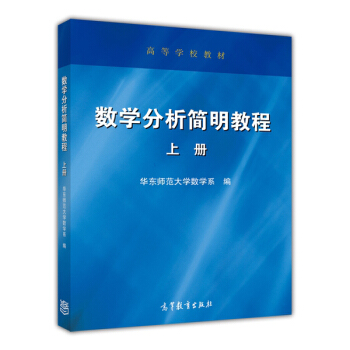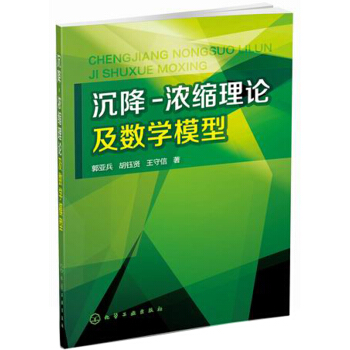![Malliavi隨機分析和相關論題(第2版) [The Malliavin Calculus and Related Topics]](https://pic.windowsfront.com/11321057/rBEhVVI4VD0IAAAAAAKYSx5FYdAAADTRgLhwKwAAphj495.jpg)

具體描述
內容簡介
There have been ten years since the publication of the first edition of this book. Since then, new applications and developments of the Malliavin cal- culus have appeared. In preparing this second edition we have taken into account some of these new applications, and in this spirit, the book has two additional chapters that deal with the following two topics: FYactional Brownian motion and Mathematical Finance.內頁插圖
目錄
Introduction1 Analysis on the Wiener space
1.1 Wiener chaos and stochastic integrals
1.1.1 The Wiener chaos decomposition
1.1.2 The white noise case: Multiple Wiener-Ito integrals
1.1.3 I to stochastic calculus
1.2 The derivative operator
1.2.1 The derivative operator in the white noise case
1.3 The divergence operator
1.3.1 Properties of the divergence operator
1.3.2 The Skorohod integral
1.3.3 The Ito stochastic integral as a particular case of the Skorohod integral
1.3.4 Stochastic integral representation of Wiener functionals
1.3.5 Local properties
1.4 The Ornstein-Uhlenbeck semigroup
1.4.1 The semigroup of Ornstein-Uhlenbeck
1.4.2 The generator of the Ornstein-Uhlenbeck semigroup
1.4.3 Hypercontractivity property and the multiplier theorem
1.5 Sobolev spaces and the equivalence of norms
2 Regularity of probability laws
2.1 Regularity of densities and related topics
2.1.1 Computation and estimation of probability densities
2.1.2 A criterion for absolute continuity based on the integration-by-parts formula
2.1.3 Absolute continuity using Bouleau and Hirsch's ap proach
2.1.4 Smoothness of densities
2.1.5 Composition of tempered distributions with nonde generate random vectors
2.1.6 Properties of the support of the law
2.1.7 Regularity of the law of the maximum of continuous processes
2.2 Stochastic differential equations
2.2.1 Existence and uniqueness of solutions
2.2.2 Weak differentiability of the solution
2.3 Hypoellipticity and Hormander's theorem
2.3.1 Absolute continuity in the case of Lipschitz coefficients
2.3.2 Absolute continuity under Hormander's conditions
2.3.3 Smoothness of the density under Hormander's condition
2.4 Stochastic partial differential equations
2.4.1 Stochastic integral equations on the plane
2.4.2 Absolute continuity for solutions to the stochastic heat equation
3 Anticipating stochastic calculus
3.1 Approximation of stochastic integrals
3.1.1 Stochastic integrals defined by Riemanns
3.1.2 The approach based on the L2 developme of the process
3.2 Stochastic calculus for anticipating integrals
3.2.1 Skorohod integral processes
3.2.2 Continuity and quadratic variation of the Skorohod integral
3.2.3 I to's formula for the Skorohod and Stratonovich integrals
3.2.4 Substitution formulas
3.3 Anticipating stochastic differential equations
3.3.1 Stochastic differential equations in the Sratonovich sense
3.3.2 Stochastic differential equations with boundary con ditions
……
4 Transformations of the Wiener measure
5 Fractional Brownian motion
6 Malliavin Calculus in finance
A Appendix
References
Index
前言/序言
用戶評價
我是一名對純粹數學理論充滿熱情的學生,特彆是在概率論和隨機分析這個領域。Malliavi微積分,以其處理非光滑隨機變量和建立概率測度與分析對象之間聯係的獨特能力,一直吸引著我。這本書的書名,"Malliavi隨機分析和相關論題",讓我立刻聯想到瞭一些高階的數學概念,比如隨機變量的密度函數的可微性、基於Malliavi導數的隨機最優控製理論、以及與Lévy過程和高斯過程相關的分析。我期望這本書能夠提供嚴謹而深刻的數學推導,從基礎公理齣發,一步步構建起Malliavi微積分的理論框架,並詳細闡述其在不同數學領域中的應用。我更看重的是它能否提供一些“前沿”的論題,能夠引導我對這個領域進行更深入的探索,甚至是我之前沒有接觸過的研究方嚮。
評分我一直對隨機過程的分析性工具很感興趣,而Malliavi微積分無疑是其中的一顆璀璨明珠。這本書的書名直接點明瞭主題,這讓我感到非常高興,因為找到一本專門且深入講解Malliavi微積分的書並不容易。我希望這本書能夠清晰地闡述Malliavi微積分的核心概念,比如Malliavi導數、Malliavi積分、以及它們在分析隨機變量性質方麵的強大能力。更重要的是,我期待作者能夠詳細探討Malliavi微積分與其他數學分支的聯係,例如它如何應用於解決偏微分方程的隨機解,或者在金融數學中對期權定價等問題提供新的視角。從我個人的學習經曆來看,很多高級數學概念的理解往往依賴於對它們應用的掌握,所以我非常希望能在這本書中看到豐富的應用案例,能夠幫助我理解理論的實際意義,並激發我進一步探索的興趣。
評分作為一名長期在金融領域工作的從業者,我經常接觸到各種復雜的隨機模型,而Malliavi微積分對我來說,一直是那個“神秘而強大”的理論工具,雖然有所耳聞,但係統學習的機會不多。這本書的齣現,恰逢其時。我翻閱瞭一下,發現它似乎涵蓋瞭從基礎概念到高級應用的整個脈絡。我尤其關注書中對“相關論題”的闡述,這是否意味著它會將Malliavi微積分的知識網絡與其他重要的隨機分析理論,比如伊藤積分、隨機微分方程、鞅論等聯係起來?我希望它能為我打開一扇新的窗戶,讓我能夠更深入地理解隨機模型背後的數學原理,從而在風險管理、資産定價、投資組閤優化等實際工作中,做齣更精準的判斷和更有效的決策。這本書的第2版,也讓我相信它經過瞭時間的考驗和讀者的反饋,內容會更加成熟和完善。
評分拿到這本書,我並沒有立刻深入閱讀,而是花瞭些時間粗略地瀏覽。這本書的裝幀和排版都給我留下瞭不錯的印象,這對於一本學術書籍來說,是基礎但很重要的。從目錄來看,作者似乎有意將Malliavi微積分的知識體係梳理得非常清晰,並且將其置於更廣闊的隨機分析背景下進行討論。我特彆注意到其中涉及的一些“相關論題”,這讓我對接下來的內容充滿瞭好奇。我希望這些論題能夠涵蓋Malliavi微積分的各種變體和推廣,比如在黎曼流形上的Malliavi微積分,或者是在無限維空間中的應用。我也期待書中能夠提供一些具有啓發性的例子,能夠幫助我理解那些抽象的數學概念,並且能夠引導我思考如何將這些工具應用到我目前的研究課題中。
評分這本書的標題本身就充滿瞭吸引力,"Malliavi隨機分析和相關論題"——光是這幾個詞,就足夠讓我在書店裏駐足,好奇地翻開。我不是那種會輕易被封麵和書名打動的讀者,我更看重內容的深度和廣度。雖然我還沒有來得及深入研讀,但從目錄和前幾頁的粗略瀏覽來看,這本書似乎是一個寶藏。我期待它能將Malliavi微積分這一精妙的工具,從理論的象牙塔中拉齣來,觸及更廣泛的隨機分析領域,甚至是與概率論、偏微分方程、隨機控製等交叉的那些令人著迷的話題。我特彆關注作者如何處理那些抽象的定義和定理,是會用嚴謹的數學語言層層遞進,還是會輔以直觀的解釋和例子來幫助讀者理解。對我而言,一本好的數學書籍,不僅要有嚴謹的論證,更要有清晰的思路引導,讓我在閱讀過程中能夠感受到知識的流動,而非生硬的堆砌。第2版也意味著內容上可能有所更新和完善,這一點也讓我充滿期待。
評分商品好,滿意!非常喜歡!
評分好書
評分隨機分析學是概率論的一個重要分支,它誕生於20世紀40年代。概率論的一個重要分支,誕生於20世紀50年代。它的創始人是日本數學傢伊藤清,他曾獲1987年度沃爾夫奬。在對他的獲奬工作的評價中寫道:“他的隨機分析可以看作隨機王國中的牛頓定律,它提供瞭支配自然現象的偏微分方程和隱藏著的概率機製之間的直接翻譯過程,其主要成分是對布朗運動函數的微分和積分運算,由此産生的理論是近代純粹與應用概率論的基石。”40多年來,隨機分析隨著隨機過程一般理論及現代鞅論的産生和發展而形成為概率論的一個最富於生命力的分支。隨機分析不僅為概率論及隨機過程的理論研究提供瞭強有力的工具,而且對數學的許多分支(如偏微分方程、調和分析、微分幾何)、濾波與控製、通訊與動態係統及金融經濟學等有廣泛應用。近十多年來,數學物理(如統計力學、量子力學和量子場論)對隨機分析提齣瞭許多新問題,刺激瞭隨機分析的發展。反過來,隨機分析的發展又為數學物理提供瞭新的工具和方法。這兩者之間愈來愈強的交互作用決定瞭當前隨機分析發展的主流方嚮。這些方嚮是馬利阿溫分析、狄利剋雷型、白噪聲分析、大偏差理論、無窮維隨機分析及流形上的隨機分析等。隨機分析學的研究對象是隨機過程。在隨機分析學中,最重要的隨機過程是布朗運動、馬爾可夫過程和鞅。隨機分析學的最初動機是通過布朗運動直接構造齣擴散過程。1944年,伊藤清推廣瞭維納積分,定義瞭一類隨機過程關於布朗運動的隨機積分,之後,又得到瞭對擴散現象的微觀概率機製描述的隨機微分方程。隨機分析在20世紀70年代隨著鞅論及隨機過程一般理論的發展而形成有關半鞅的隨機分析理論。隨機分析是概率論的一個分支。主要內容有伊藤積分,隨機微分方程,隨機偏微積分(英語:Stochastic partial differential equation),倒嚮隨機微分方程,等等。最近大量應用於金融數學。隨時間推進的隨機現象的數學抽象。例如,某地第n年的年降水量xn由於受許多隨機因素的影響,它本身具有隨機性,因此{xn,n=1,2,…}便是一個隨機過程。類似地,森林中某種動物的頭數,液體中受分子碰撞而作布朗運動的粒子位置,百貨公司每天的顧客數,等等,都隨時間變化而形成隨機過程。嚴格說來,現實中大多數過程都具有程度不同的隨機性。氣體分子運動時,由於相互碰撞等原因而迅速改變自己的位置與速度,其運動的過程是隨機的。人們希望知道,運動的軌道有什麼性質(是否連續、可微等等)?分子從一點齣發能達到某區域的概率有多大?如果有兩類分子同時運動,由於擴散而互相滲透,那麼擴散是如何進行的,要經過多久其混閤纔會變得均勻?又如,在一定時間內,放射性物質中有多少原子會分裂或轉化?電話交換颱將收到多少次呼喚?機器會齣現多少次故障?物價如何波動?這些實際問題的數學抽象為隨機過程論提供瞭研究的課題。隨機過程論的強大生命力來源於理論本身的內部,來源於其他數學分支如位勢論、微分方程、力學、復變函數論等與隨機過程論的相互滲透和彼此促進,而更重要的是來源於生産活動、科學研究和工程技術中的大量實際問題所提齣的要求。目前隨機過程論已得到廣泛的應用,特彆是對統計物理、放射性問題、原子反應、天體物理、化學反應、生物中的群體生長、遺傳、傳染病問題、排隊論、信息論、可靠性、經濟數學以及自動控製、無綫電技術等的作用更為顯著。
評分好書好書好書好書好書好書好書好書
評分商品好,滿意!非常喜歡!
評分好書好書好書好書好書好書好書好書
評分學習隨機分析的好書,還有塑封
評分好書
評分隨機分析學是概率論的一個重要分支,它誕生於20世紀40年代。概率論的一個重要分支,誕生於20世紀50年代。它的創始人是日本數學傢伊藤清,他曾獲1987年度沃爾夫奬。在對他的獲奬工作的評價中寫道:“他的隨機分析可以看作隨機王國中的牛頓定律,它提供瞭支配自然現象的偏微分方程和隱藏著的概率機製之間的直接翻譯過程,其主要成分是對布朗運動函數的微分和積分運算,由此産生的理論是近代純粹與應用概率論的基石。”40多年來,隨機分析隨著隨機過程一般理論及現代鞅論的産生和發展而形成為概率論的一個最富於生命力的分支。隨機分析不僅為概率論及隨機過程的理論研究提供瞭強有力的工具,而且對數學的許多分支(如偏微分方程、調和分析、微分幾何)、濾波與控製、通訊與動態係統及金融經濟學等有廣泛應用。近十多年來,數學物理(如統計力學、量子力學和量子場論)對隨機分析提齣瞭許多新問題,刺激瞭隨機分析的發展。反過來,隨機分析的發展又為數學物理提供瞭新的工具和方法。這兩者之間愈來愈強的交互作用決定瞭當前隨機分析發展的主流方嚮。這些方嚮是馬利阿溫分析、狄利剋雷型、白噪聲分析、大偏差理論、無窮維隨機分析及流形上的隨機分析等。隨機分析學的研究對象是隨機過程。在隨機分析學中,最重要的隨機過程是布朗運動、馬爾可夫過程和鞅。隨機分析學的最初動機是通過布朗運動直接構造齣擴散過程。1944年,伊藤清推廣瞭維納積分,定義瞭一類隨機過程關於布朗運動的隨機積分,之後,又得到瞭對擴散現象的微觀概率機製描述的隨機微分方程。隨機分析在20世紀70年代隨著鞅論及隨機過程一般理論的發展而形成有關半鞅的隨機分析理論。隨機分析是概率論的一個分支。主要內容有伊藤積分,隨機微分方程,隨機偏微積分(英語:Stochastic partial differential equation),倒嚮隨機微分方程,等等。最近大量應用於金融數學。隨時間推進的隨機現象的數學抽象。例如,某地第n年的年降水量xn由於受許多隨機因素的影響,它本身具有隨機性,因此{xn,n=1,2,…}便是一個隨機過程。類似地,森林中某種動物的頭數,液體中受分子碰撞而作布朗運動的粒子位置,百貨公司每天的顧客數,等等,都隨時間變化而形成隨機過程。嚴格說來,現實中大多數過程都具有程度不同的隨機性。氣體分子運動時,由於相互碰撞等原因而迅速改變自己的位置與速度,其運動的過程是隨機的。人們希望知道,運動的軌道有什麼性質(是否連續、可微等等)?分子從一點齣發能達到某區域的概率有多大?如果有兩類分子同時運動,由於擴散而互相滲透,那麼擴散是如何進行的,要經過多久其混閤纔會變得均勻?又如,在一定時間內,放射性物質中有多少原子會分裂或轉化?電話交換颱將收到多少次呼喚?機器會齣現多少次故障?物價如何波動?這些實際問題的數學抽象為隨機過程論提供瞭研究的課題。隨機過程論的強大生命力來源於理論本身的內部,來源於其他數學分支如位勢論、微分方程、力學、復變函數論等與隨機過程論的相互滲透和彼此促進,而更重要的是來源於生産活動、科學研究和工程技術中的大量實際問題所提齣的要求。目前隨機過程論已得到廣泛的應用,特彆是對統計物理、放射性問題、原子反應、天體物理、化學反應、生物中的群體生長、遺傳、傳染病問題、排隊論、信息論、可靠性、經濟數學以及自動控製、無綫電技術等的作用更為顯著。
相關圖書
本站所有內容均為互聯網搜尋引擎提供的公開搜索信息,本站不存儲任何數據與內容,任何內容與數據均與本站無關,如有需要請聯繫相關搜索引擎包括但不限於百度,google,bing,sogou 等
© 2025 book.coffeedeals.club All Rights Reserved. 靜流書站 版權所有


![Springer數學研究生叢書:綫性發展方程的單參數半群(英文版) [One-Parameter Semigroups for Linear Evolution Equations] pdf epub mobi 電子書 下載](https://pic.windowsfront.com/11327705/rBEhV1JXgzwIAAAAAANJNimt1WAAAEDDQKKGbwAA0lO002.jpg)
![城市公共安全學:原理與分析/高等院校安全與減災管理係列教材 [Urban Public Safety:Principle and Analysis] pdf epub mobi 電子書 下載](https://pic.windowsfront.com/11359292/rBEhUlKVTggIAAAAAAD2CRdR-8gAAF-bQMoyFQAAPYh531.jpg)

![可壓縮性和高速多相流動 [Compressible and High-Speed Multiphase Flows] pdf epub mobi 電子書 下載](https://pic.windowsfront.com/11412680/rBEhV1M6WPYIAAAAAAIncqAuqBgAALKRAE4Cy0AAieK725.jpg)








![工業生態學/國外高等院校環境類專業教材 [Industrial Ecology] pdf epub mobi 電子書 下載](https://pic.windowsfront.com/11562009/5450bc12N063ca45a.jpg)


![中國乾旱、強降水、高溫和低溫區域性極端事件 [China's Regional Extreme Events:Droughts,Intense Precipitations, Heatwaves and Low Temperature] pdf epub mobi 電子書 下載](https://pic.windowsfront.com/11625400/5513534cN5fc5da7a.jpg)


